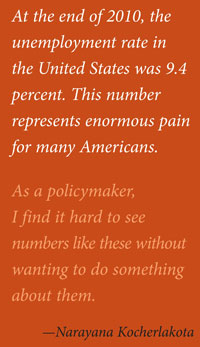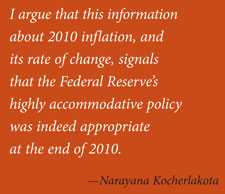* Prepared using data through April 2011.
 At the end of 2010, the unemployment rate in the United States was 9.4 percent. This was lower than its recent 2009 peak of over 10 percent, but still higher than at any other time since the early 1980s. Even more disturbingly, nearly half of those who were unemployed had been without a job for over six months—a number without precedent since World War II. These numbers represent enormous pain for many Americans. And they represent a huge amount of lost output for the country, as millions of Americans who want to work are unable to do so. As a policymaker, I find it hard to see numbers like these without wanting to do something about them.
At the end of 2010, the unemployment rate in the United States was 9.4 percent. This was lower than its recent 2009 peak of over 10 percent, but still higher than at any other time since the early 1980s. Even more disturbingly, nearly half of those who were unemployed had been without a job for over six months—a number without precedent since World War II. These numbers represent enormous pain for many Americans. And they represent a huge amount of lost output for the country, as millions of Americans who want to work are unable to do so. As a policymaker, I find it hard to see numbers like these without wanting to do something about them.
 But every U.S. policymaker has constraints imposed upon him or her by statute or regulation. (Which, I might add, is a very good thing!) In a recent speech, William Dudley, president of the Federal Reserve Bank of New York and vice-chair of the Federal Open Market Committee, summarized the job of the Federal Reserve in this way: “Congress has set an explicit objective for monetary policy: To pursue the highest level of employment consistent with price stability.”* I like this elegant formulation a great deal. It says that Congress wants the Federal Reserve to make choices that will keep unemployment low insofar as those choices generate inflation that is neither too high nor too low.
But every U.S. policymaker has constraints imposed upon him or her by statute or regulation. (Which, I might add, is a very good thing!) In a recent speech, William Dudley, president of the Federal Reserve Bank of New York and vice-chair of the Federal Open Market Committee, summarized the job of the Federal Reserve in this way: “Congress has set an explicit objective for monetary policy: To pursue the highest level of employment consistent with price stability.”* I like this elegant formulation a great deal. It says that Congress wants the Federal Reserve to make choices that will keep unemployment low insofar as those choices generate inflation that is neither too high nor too low.
But implementing this formulation of the Federal Reserve’s job immediately confronts us with some practical difficulties. I think about Congress’ mandate of price stability as requiring the Federal Reserve to follow policies that will give rise to an average annual inflation rate of 2 percent over the next three to four years. What exactly is the highest level of employment consistent with that definition of price stability? The answer to that question would be easy to estimate if that maximum employment level remained constant over time, but the high- inflation, high-unemployment period of the 1970s taught us that it does not.
In the Annual Report essay that follows, I discuss how policymakers can use real-time data to make monetary policy choices that allow them to achieve the “highest level of employment consistent with price stability.” My main conclusion is that data on aggregate labor market quantities like unemployment and job openings are highly imperfect guides to the making of monetary policy in the context of an ever-changing macroeconomy. Fortunately, I do find that data on the rate of change of inflation can be a useful supplementary source of information.
 Along those lines, over the course of 2010, PCE (personal consumption expenditure) inflation was near 1 percent (whether food and energy are included or not). The rate of change of inflation was low, because 1 percent was well below 2009 inflation and well below what inflation was expected to be in 2011. The level of inflation was also low compared with the target inflation rate of 2 percent that I mentioned earlier. In the Annual Report essay, I argue that this information about 2010 inflation, and its rate of change, signals that the Federal Reserve’s highly accommodative policy of low interest rates and large-scale asset purchases was indeed appropriate at the end of 2010.
Along those lines, over the course of 2010, PCE (personal consumption expenditure) inflation was near 1 percent (whether food and energy are included or not). The rate of change of inflation was low, because 1 percent was well below 2009 inflation and well below what inflation was expected to be in 2011. The level of inflation was also low compared with the target inflation rate of 2 percent that I mentioned earlier. In the Annual Report essay, I argue that this information about 2010 inflation, and its rate of change, signals that the Federal Reserve’s highly accommodative policy of low interest rates and large-scale asset purchases was indeed appropriate at the end of 2010.
Of course, conditions change. What was appropriate at the end of 2010 may no longer be appropriate in 2011. I will be watching the evolution of inflation during 2011 carefully. But that is a subject for a future Annual Report essay.
Narayana Kocherlakota
President
* Dudley, William C. 2011. “The Road to Recovery: Hudson Valley.” Remarks at the Dutchess County Regional Chamber of Commerce, Fishkill, N.Y., May 20.





